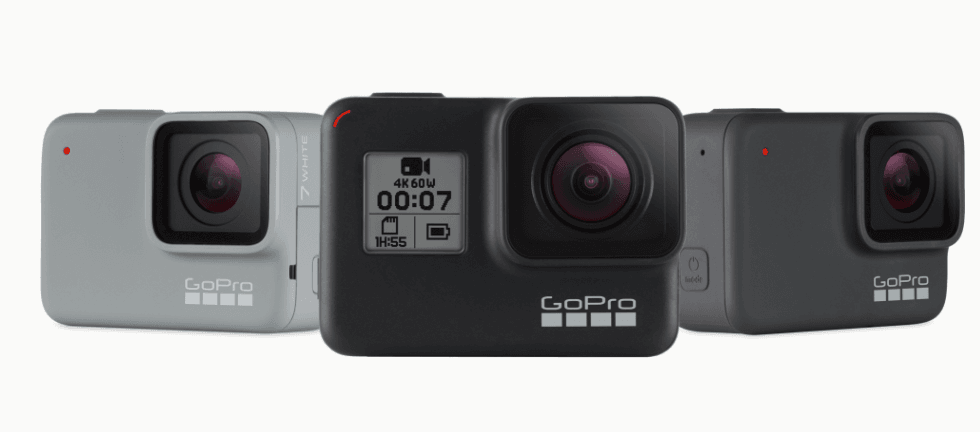The GoPro Hero 7 line-up went on sale last week in the U.S. and globally. The company is offering three models this time: White, Silver and Black, which are priced at $199, $299 and $399, respectively.
What makes the GoPro Hero 7 Black different?
The GoPro Hero 7 Black is the premium model, and it replaces the now-discontinued Hero 6 Black. The black variant comes with “Hypersmooth” electronic image stabilization, which GoPro founder Nick Woodman claims is the “best in-camera video stabilization in any camera, ever.”
According to the company, the feature will smooth out videos taken in motion. The software-based Hypersmooth feature uses a built-in gyroscope to digitally manage movements in the recording. It could mean videos will be cropped. Other than this new addition, the GoPro Hero 7 Black is similar to its predecessor.
It features the same 12-megapixel sensor and custom GP 1 processor. However, the RAM has gotten a small bump up. Further, the Hero 7 Black has the same recording capabilities: 1080p video at 240 fps, 2K video at 120 fps and 4K video at 60 fps. It supports scene detection and can remove wind noise.
Apart from these features, the Hero 7 comes with GPS location tracking, the option to live-stream (on Facebook, Twitch, YouTube, or Vimeo) and waterproofing up to 10 meters deep. The high-end variant also has a time-lapse mode called “TimeWarp,” which makes it easier to capture fast time-lapse videos. It also has a new “SuperPhoto” mode, which does the same job as the smart HDR features on the iPhone and Pixel phones.
The camera’s rubbery black exterior has received some minor tweaks, including the addition of the name on the side. Though the user interface has also been tweaked a bit, it will feel familiar to anyone who has used the Hero 5 or Hero 6 Black. The GoPro Hero 7 Black was launched internationally on Sept. 27, while in the U.S., it went on sale on Sept. 30.
Common features in all three cameras
The GoPro Hero 7 Silver and White are pocket-friendly variants priced at $299 and $199, respectively. They don’t have the GP1 sensor or HyperSmooth stabilization, but they do feature a 10-megapixel sensor. They also lack the LCD status screen on the front. The Silver variant supports only up to 4K video at 30 fps, while the White model can record up to 1440p at 60 fps.
All three new cameras are the same sizes as their predecessors, so they will be compatible with existing mounts and accessories. All three are also waterproof, feature touchscreen LCDs and voice control, and can automatically store footage on GoPro’s cloud subscription service.
All three new GoPro Hero 7 cameras can shoot and save vertical photos and videos as well. They also have a new “short clips” feature, which allows users to shoot 15- or 30-second videos. Such a feature could prove very handy for Instagram users. GoPro has also worked on the interface, and the biggest change is the option to swipe left and right to switch between modes.
Can the Hero 7 turn things around for GoPro?
Since 2015, the company has just been releasing new versions of the Hero camera without giving them much thought. Even the prices have been criticized. For instance, the Hero 6 Black came with a super-premium price tag of $499. GoPro’s plight is reflected in its share price as well. The stock is down more than 30% in the last 12 months. In January, the company slashed its global workforce by 20% and abandoned its Karma product line.
GoPro now will be hoping that the Hero 7 line will help it put an end to the troubles that it has been facing for the past few years. Others are also hoping the new GoPro Hero 7 line will help the company bounce back.
Recently, Oppenheimer analyst Andrew Uerkwitz upgraded the company’s stock from Perform to Outperform, citing optimism around the refreshed product line. Uerkwitz also slapped a $9 target price on the stock (GoPro is currently trading at a little over $7).
“With compelling features such as live streaming and gimbal-like image stabilization, we believe the products are compelling,” the analyst said.
The Oppenheimer analyst notes that the stock has “fallen off everyone’s radar” following the “difficult years.” However, the company now has a well-defined strategy to turn things around. GoPro has also been able to reduce its inventory, which, according to the Uerkwitz, has been its “biggest headache” for the past two years.
“GoPro has never had competitive issues. Its stock depreciation has largely been self-inflicted or moonshots that didn’t land,” the analyst said.
Uerkwitz believes reducing inventory and launching the GoPro Hero 7 line will help the company return to growth.
In a recent interview with The Verge, GoPro CEO Nick Woodman said the company will continue to sell all three 2018 GoPro Hero cameras for the foreseeable future. The camera maker is also considering removing some accessories from the lineup. For example, GoPro can drop the handheld Karma Grip stabilizer now, as it has introduced the HyperSmooth stabilization feature.





